Castle of Blood (1964)
Directed by: Antonio Margheriti, Sergio Corbucci
Written by: Bruno Corbucci, Giovanni Grimaldi
Starring: Arturo Dominici, Barbara Steele, Georges Rivière, Margrete Robsahm
ITALY
AVAILABLE ON BLU-RAY, DVD and DVD
RUNNING TIME: 96 mins / 87 mins
REVIEWED BY: Dr Lenera
SPOILERS!

Journalist Alan Foster has been pestering Edgar Allan Poe for five days with letters asking for an interview, and finally gets one when he finds him in a tavern with Lord Thomas Blackwood. It’s November the 1st, the “Night of the Dead”, and Blackwood challenges Foster to spend the night alone in his haunted castle which is only two hour’s drive by carriage away. Supposedly anybody who does such a thing dies, the most recent two being a married couple who are now buried in the cemetery there. Foster will get £10 if he survives. The place is eerie, but Foster remains sceptical, even when he meets Elisabeth, who lives on the second floor, and sleeps with her despite another woman named Julia not seeming too happy about this. When things get even weirder and other inhabitants of the castle behave in strange ways, it’s up to Dr. Carmus to explains to Foster what exactly is happening in this strange place….
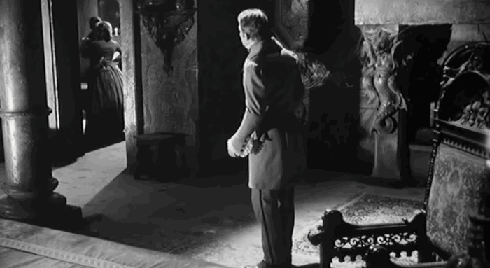
It’s one of a film lover’s greatest pleasures when he or she watches a film which is so good that he or she can’t understand why it’s taken until now to see it. Life feels just a bit more complete after the experience. I knew of Castle Of Blood for decades but just by its title, and that it was directed by Antonio Margheriti, a filmmaker who doesn’t have a particularly good reputation among cineastes even of the culty kind, rarely seeming worthy of being mentioned in the same breath as the genre’s Holy Trinity, and less celebrated than the likes of Sergio Martino and Ruggero Deodato. However, there it was, on a Region A Blu-ray I recently obtained which contained two of Barbara Steele’s other’60s Italian Gothics but relegated Castle Of Blood to almost “extra” status and in a scratchy cinema print. But, despite being in a version which was greatly toned down and simplified from its original Italian incarnation, it turned out to be one of the creepiest and most interesting ghost stories I’d seen in ages, even if most of its ideas were hardly new, and I couldn’t understand why it wasn’t better known and regarded. Obtaining a much better version became urgent, and luckily one came out, but in either version – and it’s easy to hate the way American distributors would alter and weaken imported horrors to supposedly make them more palatable for domestic audiences – Castle Of Blood, despite – or perhaps because of – elements of its compelling plot being rather vague – is a highpoint of the Italian Gothic cycle, a very eerie and unsettling movie which keeps the viewer on edge throughout with terrific atmosphere and suspense, while also almost serve as a commentary on watching movies. And it was only shot in 10-15 days, depending on what you read, which doesn’t seem possible considering its quality.
It was Spaghetti Western maestro Sergio Corbucci who came up with the idea for this when producer Giovanni Addessi commissioned him to make a film that would reuse the medieval sets from Corbucci’s comedy The Monk of Monza. Corbucci convinced Addessi to do this project by claiming that its story was based on a novel by “Winston And Smith” which featured Edgar Allan Poe. His brother Bruno and Gianni Grimaldi wrote the script, which is fraudulently credited to a short story by Poe. Deodato was the assistant director and claims that he persuaded Steele to star, even though she’d just done 8½ for Federico Fellini and wanted to distance herself from horror. Corbucci found that his schedule conflicted with the shoot and called upon his friend Margheriti to direct. Most recalled that Margheriti shot it TV-style by setting up three or four cameras at once to speed things up, though Steele, who as a model would surely would have been on the lookout for such things, doesn’t recall this. Maybe it was just for some scenes, or they used two cameras with actors rushing around because the next scene had already been prepared while the last scene was being shot. Margheriti still had to ask Corbucci to direct a murder scene as he was running out of time, but the release was held up for nearly a year, in which time Margheriti shot another film, The Virgin Of Nuremburg, on the same sets. Shots of Sylvia Sorrente’s breasts made it into the French release only, though are in the new restoration by Severin Films. The US version lost nine minutes, including a dialogue scene between Foster and Poe in a carriage, some of Foster’s wandering about, and perhaps most notably the shortening of all love scenes and a lesbian element. Nonetheless it did well over there, as opposed to in the UK where, despite losing some violence, it never got a proper cinema release. Disappointing box office was one reason why Margheriti remade it in 1970 as Web Of The Spider, though he later admitted this was a mistake, the colour ruining the atmosphere of what he considered to be his best work.
Freeze frame shots of London landmarks under the credits don’t go very far to convince that we’re in London afterwards, and this is also one of those films where even native prints have Anglosised names on them, with Margheriti going by his frequent non de plume Anthony Dawson, while most amusingly score composer Riz Ortolani is renamed Ritz Ortolani. The right tone is immediately set when our main protagonist walks into a pub – or is it a male member’s club seeing as it seems a bit secret? – and hears somebody telling a scary tale of screams, violated graves, disfigured bodies, missing teeth and obsessive love. The teller of this is Poe, and this film makes out that he based all of his tales on personal experiences, while Silvano Tranquilli only very superficially resembles the iconic writer. Foster, who doesn’t believe Poe’s claims about death not being the end, nonetheless seems to be finally getting his interview, and we hear the famous Poe quote about death being “the most melancholic of subjects1, at its most poetic when it allies itself to beauty – therefore the death of a beautiful woman is undoubtedly the most poetic subject in the world”. Lord Blackwood says to Foster “ I’m willing to bet 100 pounds you wont be able to spend the night in my castle in Providence….out of all those who.ve accepted my wager, no one has made it out of my castle alive”. Using the claim that no genuine journalist would carry so much cash around, Foster bizarrely reduces it to £10, and the bet is on. Poe goes with them to the place, allowing the interview to continue, until Foster is finally left at the castle, one of its towers looming menacingly behind an overgrown garden with a graveyard and a tree whose branches Foster gets rather comically tangled in, though said branches will make a very ghoulish return in the climax where you certainly won’t be laughing!
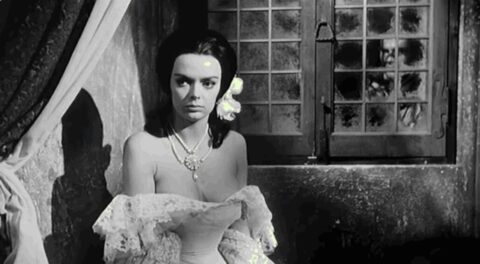
We’re only at the beginning of what’s perhaps the film’s most bravura passage, which is quite brilliant stuff, though you don’t see much of such stuff today where we almost have to have shock moments at strategic intervals. For absolutely ages all we have is one man exploring a graveyard, a tunnel with a room on its left, and then a castle, yet we’re absolutely transfixed and on edge, so much so that heavily creaking doors have rarely seemed so impactful. I’d have been happy if even more of the film had been like this. Foster is spooked by the image of a man which turns out to have been produced by a full-length mirror, a portrait of a woman briefly ripping [though he still put this down to “an optical effect”] and a door shutting on a couple dancing to music in a brightly lit room which is dark and empty when he forces the door open. We’re used to seeing arms reaching into the frame to touch someone’s shoulder, but when it’s done here we really shiver because of the incredible buildup that we’ve had. The arm belongs to Elisabeth, who seems very welcoming indeed and has even prepared her guest’s room. Apparently her brother makes the same wager every year on this night and someone always comes. Then appears Julia, who’s worried that Elisabeth told him about her, that it would have been better if he hadn’t come, and who believes that sex between the two is intended, while Elisabeth warns Julia not to interfere and stop persecuting her. “You don’t know what I’m capable of”. Our couple spend the night together, though in the morning he discovers that she has no heartbeat, while Julia is listening outside the door and a William shows up to ask her what’s going on. Then another guy called Herbert bursts in to stab Elisabeth to death, followed by other strange and usually violent events. Fortunately there’s Dr. Carmus to explain, though he’s also involved, and Foster can only watch and watch impotently as more and more things, usually killings. happen in front of him, but, as is now obvious, in different time zones.
It’s interesting that for much of the time it doesn’t just seem like it’s just us watching a film; our hero seems to be virtually watching one too, eavesdropping on things that are happening in another dimension, things which are destined to play on repeat, though there are times where we also adopt the point of view of other characters, which might strike some as being inconsistent, though it doesn’t particularly bother me, largely because it’s still like watching a movie. We finally get the expected thrilling climax which works so tremendously well because things have been undeniably slow for most of the time before. We only seem to learn the rough details of what’s really going on, and there’s some confusion as to the nature of these ghosts, who also have vampiric characteristics, but there’s something almost touching, if in a rather odd way, about spirits who want to be alive so much even if the time that they’re allowed to be alive for lasts only a few minutes and always ends with violent death, in a re-enactment of events which have to be almost ritualistically carried out once a year [shades of Brigadoon, not to mention the later and somewhat more similar crowning masterpiece from Bava Lisa And The Devil] though sometimes it seems as if they can be alive for longer. If you listen to one line, it appears that the ghost Elisabeth is essentially pimped out by her brother, cursed to replay her role of succubus with with many victims, but why are only some ghosts able to run around while there’s obvi0usly been more victims? Elisabeth seems to have a good amount of free will, as does Dr. Carmus, but why do others have very little? But then not everything needs explaining in a film like this – supernatural stuff can be more frightening if left with some mystery – and it’s great to keep thinking about stuff in this way.
While there aren’t many shock moments and special effects are either very primitive, such as a dissolve transformation – or, unusually for a Margheriti film, just not employed at all, such as a change from a room in the present to the same room being in the past handled by the latter simply being reflected on Foster’s face, there’s a partly decomposed woman who begins to breathe which looks genuinely horrid, which makes us forgive the fog which looks like cream. The nastiest bit for many viewers would be when Dr. Carmus claims that there are three states of existence- the body, the spirit and the senses – and to demonstrate this cuts off the head of a real snake and the head and body twitch. Seeing as this wouldn’t have been hard for the special effects department to realise, one wonders why, until remembering that, in Italian horror, animal lives don’t matter. Well, nothing’s perfect. In its original version the film is very sexual, with passionate love scenes including a bit where it seems to be left to the very last second before the camera slowly pans away and around the room to alight on a fire, another where somebody seems to go down on someone while the camera focuses on the lady’s face showing great pleasure, a borderline [actually it’s not borderline at all!] lesbian sexual assault [Margrete Robsahm didn’t want to do the scene until Margheriti told her to pretend it was her husband] and a main female character who clearly and unashamedly loves shagging, and possibly even with women, yet is not treated poorly by the script because of this – which is something which would probably have been the case if this were an American or British film of the time.
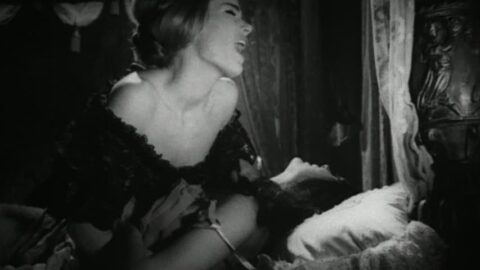
“I do not disappoint those I like” says Elisabeth, and indeed Steele has never been so carnal, yet is still pretty restrained despite dominating every scene, even ones in which her character isn’t a major participant and weird things are going on regardless of whether she’s there or not. Georges Riviera is unfortunately a bit bland as Foster, though it’s not always easy to play somebody who remains a disbeliever in the supernatural when you or I would have no doubt be converted to the cause by now seeing the crazy stuff that’s happening. Importantly though, he and Steele do have the right chemistry together, and we also feel that they’re genuinely in love. Margheriti isn’t anywhere near as much of a visual stylist as his much better known contempories, but is nonetheless entirely able to create the right feel, while cinematographer Riccardo Pallantini plays some nice games with light and shadow in the castle. Ortolani’s music score has its blood and thunder, and even a theramin at times, but is often a lot more restrained than was the norm at the time, and its an off-kilter waltz hat you’re remember most from the music for this film which really deserves minor classic status. As well as anything else, its chill really remains. Even though it finishes in seemingly sentimental romantic Hollywood weepie fashion, with the voices of two undead lovers happily talking, are we really sure that, with this lot around and even just Elisabeth alone who could very well be too much for him, that Alan will have a good calm existence now he’s fully crossed over?






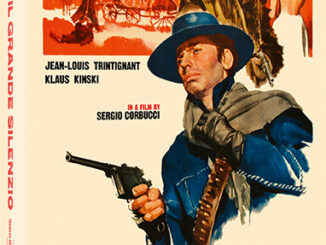
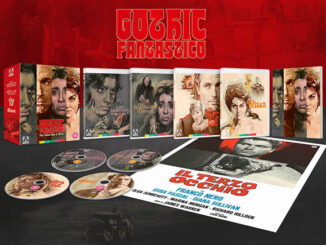
Be the first to comment